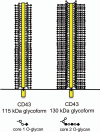T cells modulate glycans on CD43 and CD45 during development and activation, signal regulation, and survival
- PMID: 22288421
- PMCID: PMC4190024
- DOI: 10.1111/j.1749-6632.2011.06304.x
T cells modulate glycans on CD43 and CD45 during development and activation, signal regulation, and survival
Abstract
Glycosylation affects many essential T cell processes and is intrinsically controlled throughout the lifetime of a T cell. CD43 and CD45 are the two most abundant glycoproteins on the T cell surface and are decorated with O- and N-glycans. Global T cell glycosylation and specific glycosylation of CD43 and CD45 are modulated during thymocyte development and T cell activation; T cells control the type and abundance of glycans decorating CD43 and CD45 by regulating expression of glycosyltransferases and glycosidases. Additionally, T cells regulate glycosylation of CD45 by expressing alternatively spliced isoforms of CD45 that have different glycan attachment sites. The glycophenotype of CD43 and CD45 on T cells influences how T cells interact with the extracellular environment, including how T cells interact with endogenous lectins. This review focuses on changes in glycosylation of CD43 and CD45 occurring throughout T cell development and activation and the role that glycosylation plays in regulating T cell processes, such as migration, T cell receptor signaling, and apoptosis.
© 2012 New York Academy of Sciences.
Figures



References
-
- Baum LG, Crocker PR. Glycoimmunology: ignore at your peril! Immunol Rev. 2009;230:5–8. - PubMed
Publication types
MeSH terms
Substances
Grants and funding
LinkOut - more resources
Full Text Sources
Research Materials
Miscellaneous

